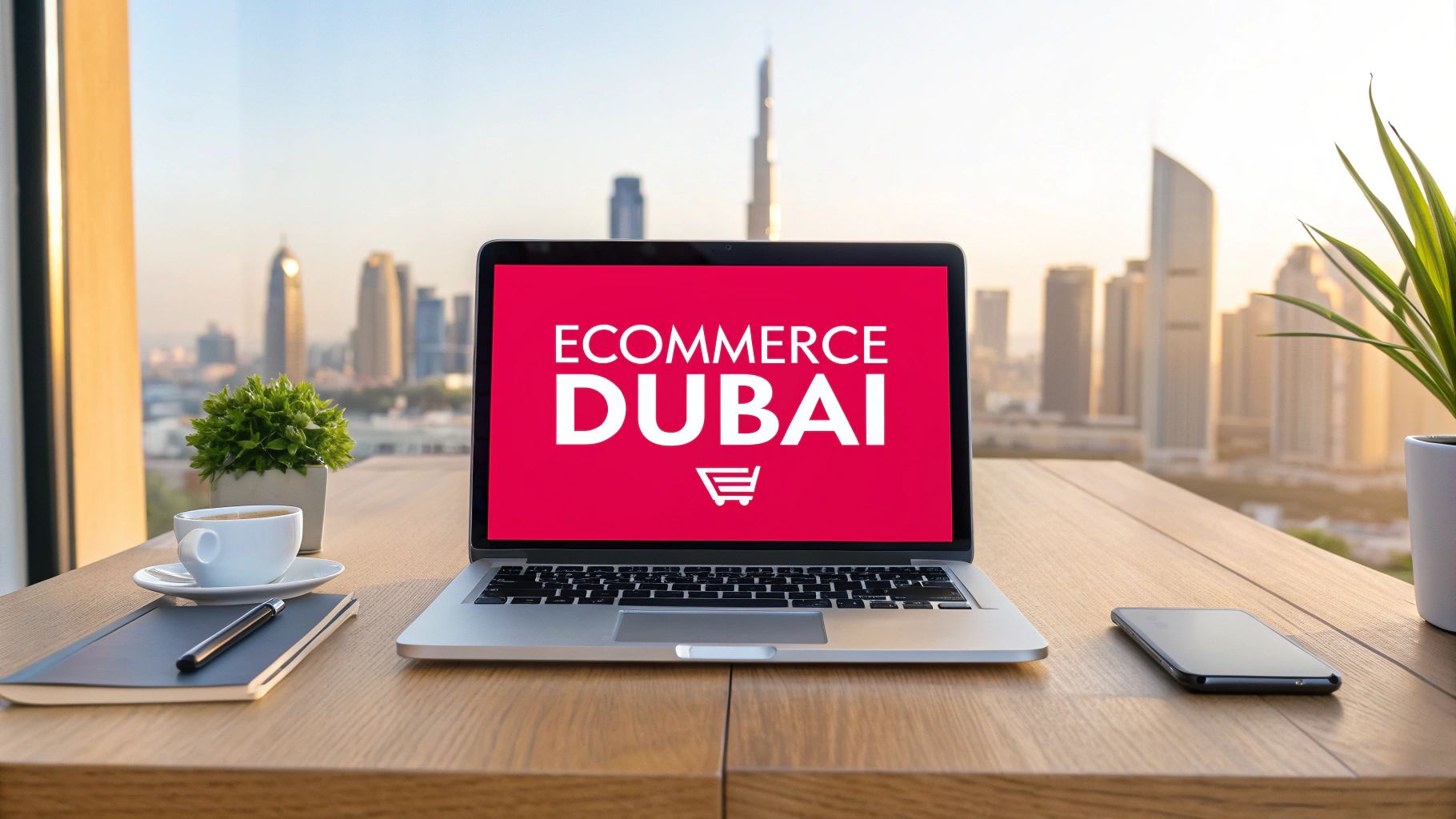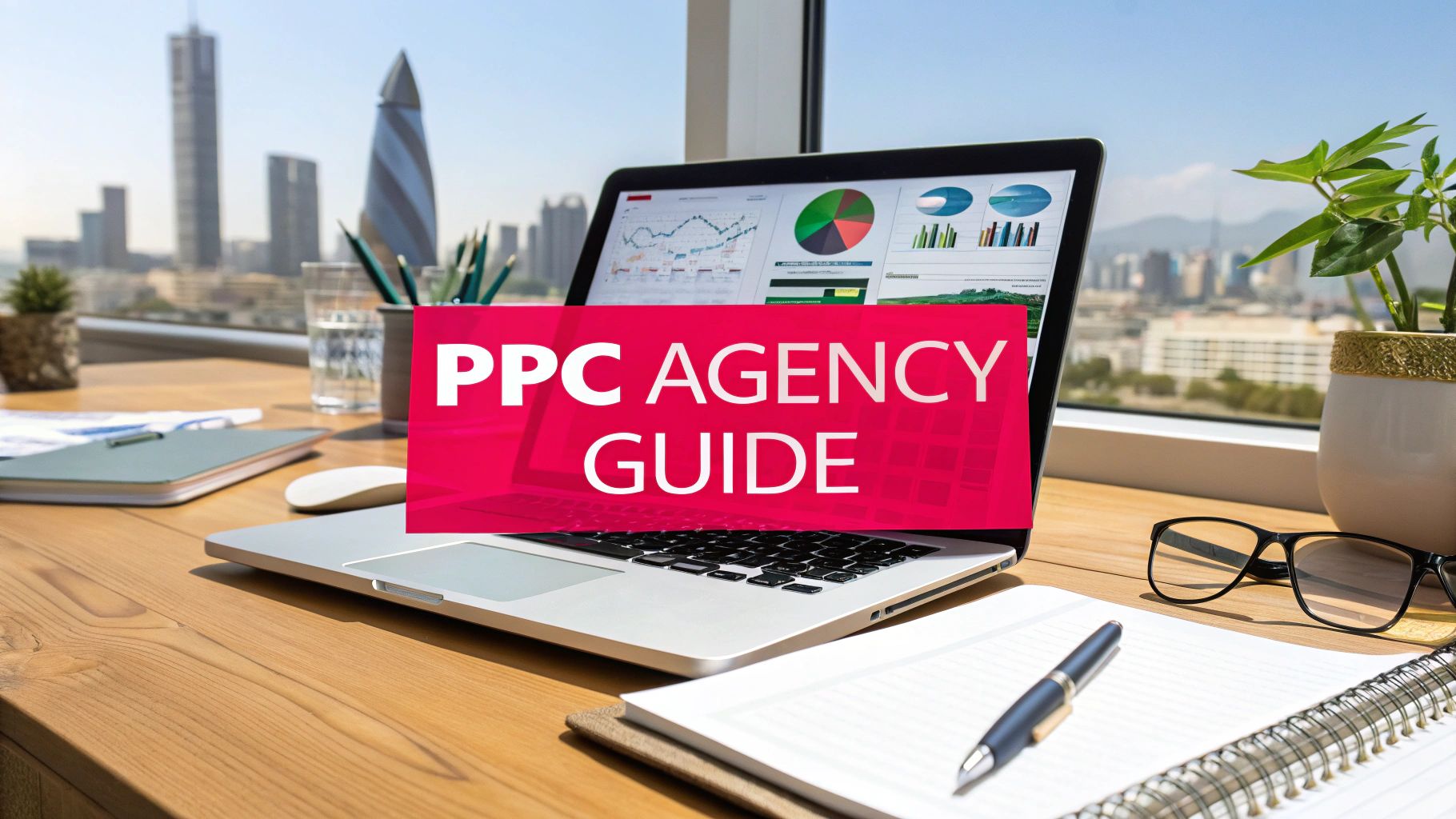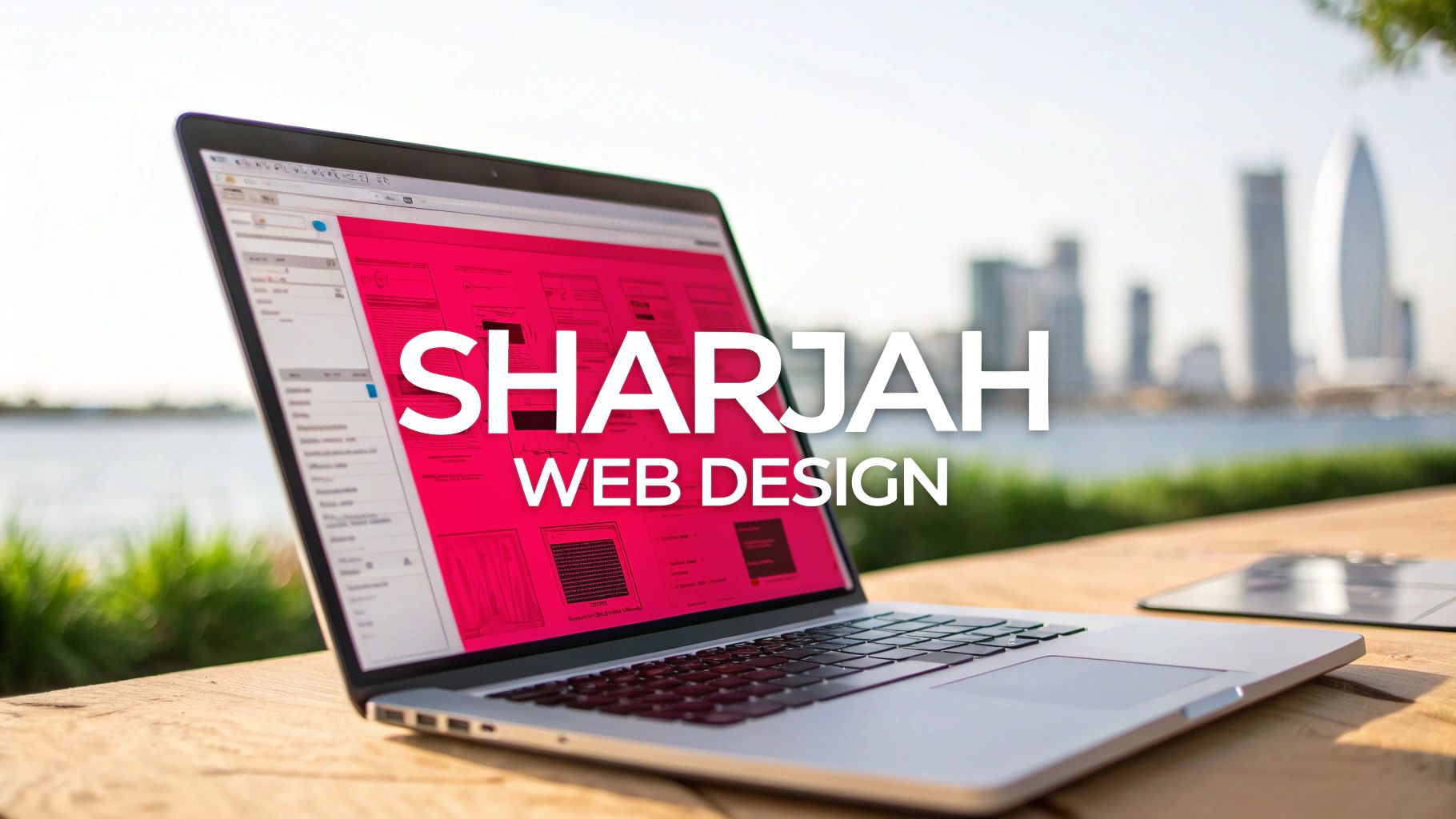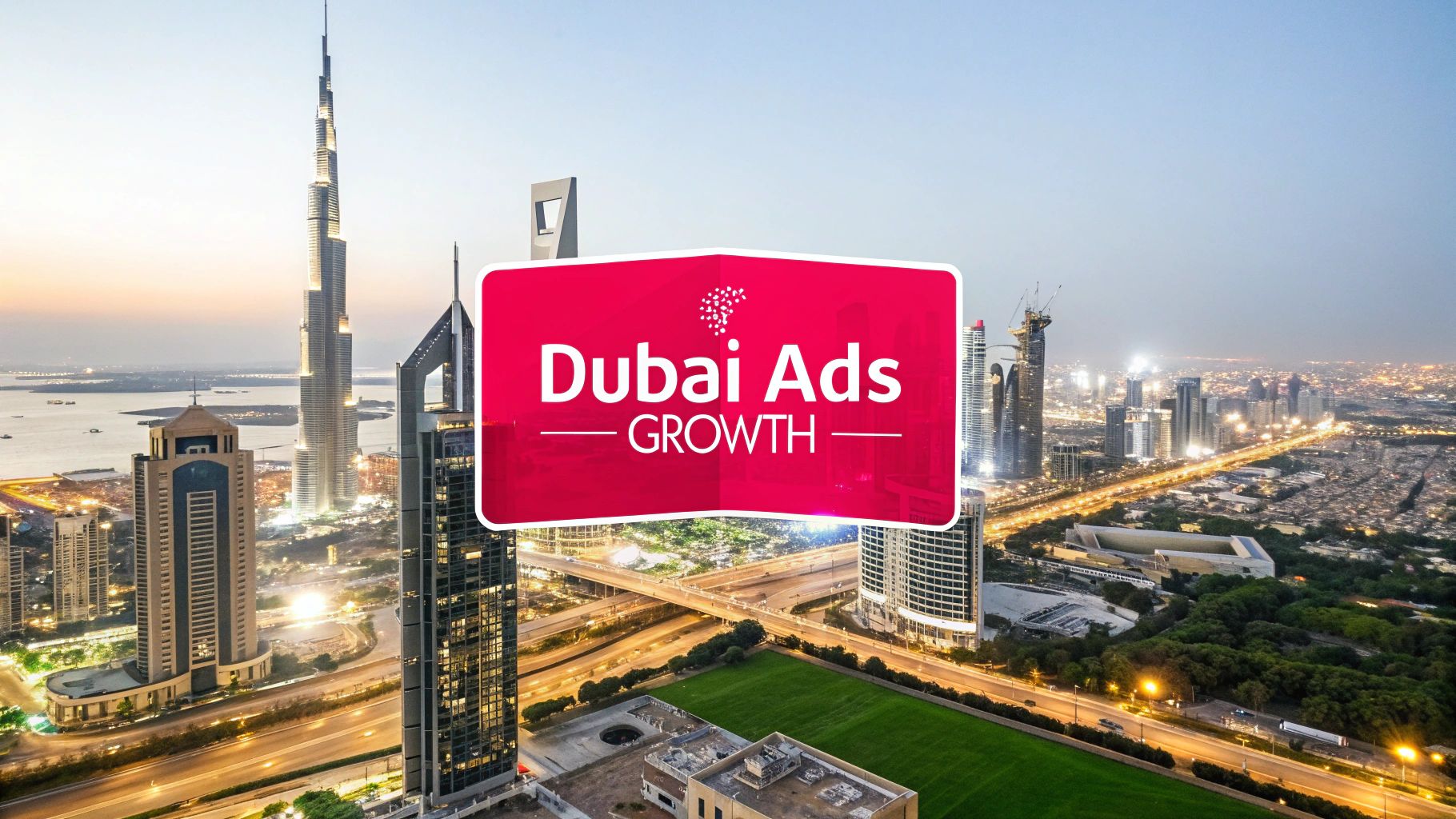An effective ecommerce website design in Dubai isn't just about looking good. It’s a careful mix of understanding local culture, building for mobile users first, and staying on the right side of the law. You're designing for a market with high expectations—one that demands a premium, seamless, and trustworthy shopping experience from the moment they land on your site.
Building Your Digital Souq For Dubai Ecommerce Success
Launching an online store in Dubai means stepping into a market that's both incredibly dynamic and digitally sharp. This isn't a place where you can just upload some products to a standard template and expect results. Think of it as building a bespoke "digital souq" – an online marketplace that truly connects with local shoppers and fits neatly into the region's unique business rules.
The journey to success here starts long before you even think about design. It all begins with a solid plan.
First, you have to get inside the mind of the UAE consumer. Shoppers here are used to the best. They expect stunning product photos, navigation that makes sense instantly, and a site that feels both high-end and secure. If you show up with a generic, one-size-fits-all website, you'll lose their attention—and their dirhams—in a heartbeat.
Securing Your Foundation Before Design
Before you touch a single design element, there are some crucial legal and logistical hurdles to clear. Don't think of these as mere paperwork; they are the absolute foundation of your business's credibility and its ability to last. I've seen too many entrepreneurs get excited and jump straight into design, only to face expensive rebuilds or legal headaches later.
Here’s a quick rundown of what you absolutely must sort out first:
- Get the Right Trade Licence: You can't legally sell anything online in the UAE without the correct trade licence. This means registering your business, whether it's with the Department of Economic Development (DED) in Dubai or within a free zone.
- Know the Data Protection Laws: The UAE takes data protection seriously. Your website's privacy policy needs to be watertight from day one, clearly explaining how you handle customer information.
- Nail Down Your Brand Identity: What is your brand's personality? Its visual style? Its core values? Get this defined. This identity will be your north star for every design choice you make.
A common mistake I see is treating the trade licence as an afterthought. Let me be clear: securing it first is non-negotiable. It proves you're a legitimate business and is almost always required to open a corporate bank account and set up the local payment gateways that customers here trust.
Before you dive into wireframes and mockups, it’s essential to have a clear roadmap. The table below outlines the critical milestones you need to hit before the creative work begins. Getting these right sets you up for a much smoother launch.
Key Planning Milestones For Your Dubai Ecommerce Website
| Milestone | Key Consideration | Why It Matters in Dubai |
|---|---|---|
| Business Registration | Secure your ecommerce trade licence from a mainland DED or a relevant free zone. | This is a legal requirement. It's also necessary for opening bank accounts and integrating with local payment processors like Telr or Payfort. |
| Domain & Hosting | Choose a .ae domain for local trust. Select a hosting provider with servers in or near the region for better site speed. |
A local domain builds credibility. Fast loading times are expected and crucial for keeping impatient shoppers engaged. |
| Brand Identity | Develop a clear brand guide including your logo, colour palette, and tone of voice. | Your brand needs to feel premium and consistent to appeal to the high expectations of UAE consumers. |
| Legal Compliance | Draft a clear, UAE-compliant Privacy Policy and Terms & Conditions. | Shoppers are savvy about data privacy. Transparency is key to building the trust needed for them to hand over their payment details. |
Hitting these milestones isn't just about ticking boxes. Each step directly impacts your ability to operate legally, build trust with your customers, and create a brand that resonates in this competitive market.
Why A Mobile-First Approach Is Non-Negotiable
The way people connect here completely shapes how you should build your website. The UAE is one of the most connected countries on the planet, with an incredible 99% internet penetration rate expected by 2025.
What does that mean for you? It means your customers are online, and they're almost certainly on their phones. In fact, over 80% of online shoppers in the UAE use their smartphones to make purchases. This isn't just a small trend; it's the dominant behaviour.
This single statistic should tell you everything you need to know: your website must work perfectly on a phone. A clunky mobile site with slow load times or a frustrating checkout process will send customers straight to your competition. It’s that simple. As you plan your digital souq, spend some time exploring the best ecommerce website design strategies and tips to make sure you get this right.
In Dubai, designing for mobile isn't an option—it's the only way to build a successful ecommerce business.
Designing for the Dubai Customer With Superior UX
In a market as dynamic as Dubai's, a pretty website is just the price of entry. To actually win, you need to deliver an exceptional user experience (UX) that feels intuitive, premium, and culturally fluent. This is where your ecommerce website design in Dubai stops being a digital catalogue and starts becoming your most powerful sales tool.

Crafting this kind of experience means you have to design with a real understanding of what local shoppers expect. Here, customers value clarity, speed, and trust above all else. A confusing layout, slow-loading images, or a clunky checkout will send them straight to your competitors in a heartbeat.
The Mobile-First Mandate
For any design to succeed in the UAE, you have to start with mobile. This isn't just a trend; it's the primary way your customers will find and interact with you. In fact, there’s a direct link between a website's mobile UX and customer retention in the UAE.
It's predicted that by 2025, over 72% of UAE internet traffic will come from mobile devices. This makes responsive design a non-negotiable business requirement. Sites built for mobile simply perform better, keeping visitors engaged longer and reducing bounce rates. That’s why it has to be your top priority.
This means every single element—from your navigation menu to product images and payment buttons—must be perfectly optimised for a smaller screen. Think thumb-friendly buttons, text that’s easy to read without squinting, and a layout that doesn't force users to constantly pinch and zoom.
Crafting an Intuitive User Journey
A great UX is all about guiding users effortlessly from your homepage all the way to checkout. The real goal is to make finding and buying a product so easy that the customer doesn't even have to think about it.
A few core principles will get you most of the way there:
- Logical Navigation: Keep your menu clean and predictable. Stick to common category names your audience will instantly understand, like "Men's Fashion," "Electronics," or "Home Décor." Don't try to reinvent the wheel here.
- Powerful Search: A prominent, intelligent search bar is absolutely essential. You’ll want to implement features like auto-complete and filters (by price, brand, size, etc.) to help shoppers quickly find what they're looking for in a large inventory.
- High-Quality Visuals: Shoppers in Dubai have high standards and expect a premium visual experience. You must invest in professional product photography and videography. The key is to use high-resolution images that are still optimised to load quickly.
Your website's user flow is like telling a story. It should have a clear beginning (landing page), middle (product discovery), and end (purchase). If a customer gets lost or confused at any point in the story, they'll simply close the book.
Embracing Bilingual Design
The UAE is a massive multicultural hub, but when it comes to commerce, Arabic and English are the dominant languages. Offering a fully bilingual website isn't just a nice-to-have; it's a fundamental sign of respect for local culture and a brilliant way to expand your customer base.
Implementing this needs to be seamless. A language toggle should instantly switch all content, including:
- Product Descriptions: All details, specs, and marketing copy.
- Navigation Menus: Every category and link across the site.
- Checkout Process: All form fields, buttons, and instructions.
- Customer Support: Your contact information and FAQ pages.
A simple language switcher, usually placed in the top corner of the header, makes your site feel accessible and welcoming to a much wider audience. If you're looking for more ways to boost performance, have a look at our guide on conversion rate optimisation best practices.
Designing Product Pages That Convert
Your product page is where the sale is won or lost. It has to give a shopper all the information they need to click "Add to Cart" with total confidence.
Here’s what every effective product page needs:
| Element | Purpose | Dubai-Specific Tip |
|---|---|---|
| Clear Pricing | Displays the cost prominently. | Always show prices in AED. If you offer instalment plans with Tabby or Tamara, display those options clearly. |
| Compelling Copy | Describes the product's benefits and features. | Use evocative language that speaks to luxury and quality, as this resonates well with local consumers. |
| Social Proof | Shows customer reviews and ratings. | Feature reviews from local customers if possible. This builds a much stronger sense of trust and community. |
| Clear CTA | A bold "Add to Cart" button. | Use a contrasting colour that stands out from the rest of the page. You want the user's eye drawn to it naturally. |
To create an experience that truly connects, you need to get inside your customer's head. Understanding the basics of consumer psychology in e-commerce retail is the key to designing pages that not only look incredible but also drive sales. When you combine these UX principles with a deep respect for local preferences, you’ll build an e-commerce experience that genuinely stands out in Dubai's bustling market.
Integrating Local Payments And Ensuring Compliance
The final click on the ‘Buy Now’ button is where a sale is won or lost. For an ecommerce website development in Dubai, getting the payment stage right is everything. This means offering payment options that locals not only recognise but actively prefer, all while operating strictly within UAE regulations.
Get this part wrong, and you're not just losing sales at the finish line—you're risking serious legal headaches.
The payment scene in the UAE is a fascinating mix of old and new. Of course, you need to accept international cards like Visa and Mastercard, but the real momentum is with local and alternative payment methods. Ignoring these is like turning away a huge chunk of your customers at the door.
And remember, most of these transactions are happening on mobile phones. The experience has to be seamless.

This just drives home the point: a mobile-first approach isn't just for browsing your catalogue. It’s absolutely fundamental for a smooth, accessible, and successful payment process where the majority of your Dubai shoppers live.
Choosing The Right Payment Gateways
Picking a payment gateway isn't just about finding the lowest fees. It’s a strategic choice that impacts user experience, security, and how smoothly it all works with your site. A clunky or untrustworthy payment process is the fastest way I’ve seen to spike cart abandonment rates.
You have to think like your customer. Are they younger shoppers who now expect flexible payment plans? Or are they more traditional buyers who just want to use their debit card? The best strategy is almost always to offer a thoughtful mix.
When building a payment stack for the Dubai market, here are the key players you need on your radar:
- Traditional Gateways: Services like Telr and Payfort (now Amazon Payment Services) are the bedrock of online payments here. They're secure, handle multiple currencies including AED, and have earned the trust of local consumers over many years.
- Buy Now, Pay Later (BNPL): This isn't a trend; it's a phenomenon. For many retailers, especially those targeting younger demographics or selling higher-ticket items, integrating Tabby or Tamara is practically non-negotiable. Allowing customers to split payments into interest-free instalments can give your conversion rates a serious boost.
- Digital Wallets: While not as dominant as in other parts of the world, offering Apple Pay and Google Pay provides that slick, one-click experience that adds a layer of pure convenience, particularly for mobile shoppers.
Comparing Popular Payment Solutions For The UAE Market
Choosing the right payment mix can feel overwhelming. To help you make an informed decision, I've put together a quick comparison of the leading payment gateways and BNPL services that are proving most effective in the UAE right now.
| Payment Solution | Best For | Key Features | Considerations |
|---|---|---|---|
| Telr | Startups and SMEs needing an all-in-one solution | Accepts a wide range of payment methods, offers social commerce links, provides good local support. | Fee structure can be complex; monthly fees may apply depending on the plan. |
| Amazon Payment Services (APS) | Established businesses looking for robust, scalable solutions | High security, tokenization, trusted brand recognition, seamless integration with the Amazon ecosystem. | Can be more technically demanding to integrate compared to simpler platforms. |
| Tabby | Retailers in fashion, beauty, electronics, and home goods | Splits payments into 4 interest-free instalments, increasing average order value and conversion. | Charges a higher merchant fee per transaction than traditional gateways. |
| Tamara | Businesses targeting high-value items and younger consumers | Offers flexible payment plans (pay in 3 or 30 days later), strong brand presence in the KSA and UAE. | Merchant fees are on the higher end; customer adoption is high but not universal. |
This table gives you a starting point, but always dig into the fine print. Look beyond the headline transaction percentage and ask about setup fees, monthly charges, and payout schedules. A clear view of these costs is crucial for your financial planning.
Navigating Legal and Compliance Requirements
Running an e-commerce business in the UAE comes with a clear set of rules designed to protect consumers and ensure a fair marketplace. Think of compliance not as a chore, but as the foundation for building a brand that customers trust and return to.
Building customer trust is paramount. In the UAE, this starts with absolute transparency. Your website must clearly display your trade licence number and registered business address, usually in the footer. This small detail instantly tells shoppers you are a legitimate, locally registered business they can rely on.
Beyond your business credentials, your site needs to meet several other legal standards. These aren't just suggestions; they are enforced by bodies like the Department of Economic Development (DED).
Here’s your essential legal checklist:
- A Clear Privacy Policy: You must be upfront with users about what data you collect and how you intend to use it, all in line with UAE data protection laws.
- Comprehensive Terms and Conditions: This document is your rulebook. It should outline everything from your shipping and returns process to payment terms and how you handle disputes.
- Accurate Product Descriptions: All product information, specs, and pricing must be truthful. Don't embellish. And critically, all prices must be clearly shown in AED.
- Secure Data Handling: This is non-negotiable. Your website must use an SSL certificate to encrypt customer data, especially during the checkout process. It's a technical and legal must-have.
By weaving together the right mix of local payment methods and making sure your site is fully compliant, you create a secure and frictionless path from browsing to buying. This doesn't just satisfy your legal duties—it builds the customer confidence that is absolutely essential for long-term success in Dubai's dynamic market.
Winning With SEO Strategies For The Dubai Market
A beautiful website is a great start, but it's only half the story. If your customers in Dubai can't find you on Google, your investment is going nowhere. This is where a sharp, localised search engine optimisation (SEO) strategy becomes your most powerful tool. SEO for the Dubai market isn’t just about stuffing keywords onto a page; it’s about genuinely understanding the search habits of a diverse, multilingual audience.

To make a real impact here, you need a plan that connects with motivated buyers at the exact moment they’re looking for what you sell. It’s a delicate mix of technical precision, cultural insight, and strategic content that’s built specifically for the UAE.
Understanding Local Search Intent
First things first: you have to get inside the head of a local shopper. How people search for products in the UAE is unique. For instance, one person might search for "luxury abayas online" in English, while another uses the Arabic term "شراء عبايات فخمة أون لاين". Both want the same thing, but their language tells you a lot.
Your keyword research has to be bilingual from day one. You need to target high-intent keywords in both English and Arabic to capture the entire market.
- English Keywords: These are often used for specific brand names or technical product queries. Think "buy iPhone 15 Pro Dubai" or "Nespresso machine offers."
- Arabic Keywords: These tend to be used for broader, more descriptive searches, like "أفضل موقع لفساتين السهرة" (best site for evening dresses).
Skipping one language means you're intentionally ignoring a huge slice of your audience. It's a common mistake that can cripple your organic traffic before you even get started.
Optimising Your On-Page Elements
Once you've got your keywords, the next job is to weave them naturally into your website's fabric. This on-page SEO is how you tell search engines what your site is all about, and it's absolutely fundamental.
For every single product and category page, make sure you've nailed these elements:
- Page Titles: Keep them descriptive and pop your main keyword in there. A good example is "Buy Men's Leather Wallets Online in Dubai | Your Brand Name".
- Meta Descriptions: Think of these as your mini-ad on Google. Write a compelling summary (around 155 characters) that includes your keyword and a clear reason to click.
- Product Descriptions: Don’t just copy-paste from the manufacturer. Write unique, detailed descriptions for every item. Use your keywords, of course, but write for a human first. What are the benefits? What makes it special?
- Image Alt Text: Describe your images accurately. This helps visually impaired users and gives search engines another clue about your page's content.
Think of on-page SEO as setting the stage. A well-optimised site gives Google's crawlers a clear script to follow, helping them understand your content's relevance and value. In a competitive market like Dubai, this isn't optional—it's essential.
Mastering Technical SEO Fundamentals
The technical health of your website is a massive ranking factor. Search engines like Google want to send their users to sites that are fast, secure, and easy to use. A top-tier e-commerce website design in Dubai has to be built on a rock-solid technical foundation.
There are three things you simply can't afford to get wrong:
| Technical Factor | Why It's Critical in the UAE | Actionable Tip |
|---|---|---|
| Site Speed | Shoppers in Dubai are impatient; they expect instant results and will bail on a slow-loading site in seconds. | Optimise your images, use a Content Delivery Network (CDN) with local servers, and keep your code lean. |
| Mobile-Friendliness | The vast majority of online shopping here happens on a phone. Google even uses mobile-first indexing. | Your site must have a responsive design that looks and works perfectly on any screen, from the latest smartphone to a tablet. |
| Site Security (HTTPS) | Trust is everything. An SSL certificate is non-negotiable for protecting customer data and is a confirmed ranking signal. | Make sure your entire site runs on HTTPS. This builds confidence and is a hard requirement for nearly all payment gateways. |
Ignoring these technical basics is one of the fastest ways to fail at SEO. No amount of great content can make up for a site that’s slow, broken on mobile, or insecure. To get a better handle on the local nuances, check out our complete guide on search engine optimisation in the UAE, which digs deeper into these topics.
Building Authority with Local Backlinks
Finally, to really climb the ranks, you need to build your site's authority. In the world of SEO, this is largely about earning backlinks—links from other respected websites pointing to yours. For the Dubai market, local relevance is king.
You should be aiming to get links from:
- Local news outlets and online magazines.
- Popular Dubai-based bloggers and influencers in your niche.
- UAE business directories and industry-specific associations.
A single, high-quality backlink from a trusted local source like Gulf News or a prominent fashion blogger is worth infinitely more than a hundred cheap links from irrelevant international sites. This sends a powerful signal to Google that you are a legitimate, trusted player in the UAE market.
Budgeting for Your Dubai E-commerce Website
So, how much does it actually cost to build an e-commerce website in Dubai? It’s the first question everyone asks, and the honest answer is: it depends. But getting a firm grip on your budget from day one is non-negotiable. It keeps the project grounded, prevents nasty financial surprises, and ensures you’re building a store that actually aligns with your business goals.
The final price tag can swing wildly based on the platform you choose, the complexity of the design, and the specific features you need to get the job done.
Let's break down the typical costs you'll encounter:
- Domain Registration: Snagging a .ae domain will usually set you back AED 50–150 a year.
- Hosting: This can be as low as AED 500 annually for a basic shared plan, or climb up to AED 5,000 and beyond for a high-performance dedicated server.
- UI/UX Design: A clean, user-friendly design is crucial. Expect to invest anywhere from AED 3,000 to AED 15,000, depending on how much customisation you need.
- Development: Here's where the costs diverge the most. A straightforward Shopify setup might start around AED 4,000, whereas a fully custom-built platform can easily exceed AED 30,000.
Crunching the Initial Setup Numbers
The first big decision you’ll make is whether to go with a hosted platform or a custom-built solution. This single choice has the biggest impact on your initial outlay.
Hosted services like Shopify are fantastic for getting to market quickly. They handle the technical heavy lifting, but you'll pay recurring monthly fees and have some limitations on deep customisation. On the other hand, a custom build gives you total freedom but requires a much larger upfront investment.
| Platform | Typical Cost | Best For | Setup Time |
|---|---|---|---|
| Shopify | AED 4,000–8,000 | Quick launch with standard features | 2–4 weeks |
| Magento/OpenCart | AED 8,000–20,000 | Mid-level customisations | 4–8 weeks |
| Custom Build | AED 20,000–50,000+ | Fully tailored solutions | 8–16 weeks |
Don't forget to factor in transaction fees and the cost of any third-party apps or integrations—these can quietly add up and affect your monthly budget.
Don't Forget the Ongoing Expenses
Launching your website is just the beginning. The real work—and cost—comes from keeping it running smoothly, securely, and effectively. If you neglect maintenance, you’re risking downtime, security vulnerabilities, and, ultimately, lost sales.
Here's a look at what you should budget for long-term:
- Hosting renewals and SSL certificates: Around AED 600–1,200 per year.
- Payment gateway fees: Typically 2–3% of every transaction.
- Technical support and updates: A monthly retainer of AED 200–500 is common.
- Marketing and SEO retainers: To actually drive traffic, plan for AED 2,000–5,000 per month.
Investing in solid, ongoing support isn't just a cost—it's an investment in your store's uptime and your customers' trust. That directly translates to higher conversions.
Tying Your Budget to Your Business Goals
Your budget isn't just a number; it's a strategic tool. It should directly reflect your sales targets and what your customers expect from you.
For instance, a boutique fashion brand might pour a larger chunk of its budget into stunning visuals and professional photography. An electronics retailer, however, would be better off prioritising lightning-fast search functionality and detailed product filtering.
By forecasting your revenue and setting clear KPIs, every dirham you spend has a purpose. And a word of advice from experience: always build in a contingency fund of 10–15%. You’ll thank yourself later when an unexpected cost pops up.
How to Manage Budget Risks
Scope creep is the silent killer of project budgets. A small "can we just add this one thing?" request can spiral, and suddenly you're way over budget. Unexpected costs also come from third-party integrations that don't play nice or new regulatory requirements.
The best defence is a clear process from the start.
- Scope Freeze: Agree on all features before a single line of code is written. Once the scope is locked, it’s locked.
- Change Requests: Any new additions or changes must go through a formal request process, with a predefined cost attached. This stops casual add-ons.
- Buffer Fund: That 10% contingency fund I mentioned? This is what it's for.
Smart Ways to Optimise Your Costs
Being on a tight budget doesn't mean you have to compromise on quality. You just need to be smarter about where you spend your money.
You can significantly reduce costs by using high-quality pre-built themes, leveraging open-source tools, and bringing in freelance specialists for specific tasks.
- Pre-built templates can save you up to 40% on initial design fees.
- Open-source platforms like Magento or OpenCart eliminate software licensing costs.
- Negotiating bulk discounts on hosting and plugins can save you a bundle over time.
- Consider a phased rollout. Launch with a Minimum Viable Product (MVP) to start generating revenue, then reinvest those profits to add more advanced features later.
Partnering with an AE-based team is also a smart move. It not only ensures you’re compliant with local laws but also helps you avoid import fees and other cross-border hassles.
Freelancer vs. Agency: What’s the Right Fit?
This is a classic dilemma. Do you hire a nimble freelancer or a full-service agency? Each has its pros and cons, and the right choice depends on your needs and budget.
| Option | Cost Range | Pros | Cons |
|---|---|---|---|
| Freelancer | AED 2,000–10,000 | Lower rates and flexible schedules | Limited ongoing support |
| Agency | AED 8,000–30,000+ | Full-service support and maintenance | Higher initial fees |
If you're looking to save on initial costs and have a straightforward project, a freelancer can be a great option. If you need comprehensive, long-term support and a team of specialists, an agency is probably the better investment.
In the end, it’s all about striking the right balance between cost and expertise. Your goal is to build a high-quality, profitable online store, and that requires smart spending.
The cost structure of e-commerce website design in Dubai reflects diverse complexities. Basic sites start at several thousand UAE dirhams, while custom-designed platforms can escalate to tens of thousands AED. Key cost drivers include domain registration, hosting, UI/UX design, frontend and backend development, maintenance and SSL certification. Read the full research about UAE e-commerce website design cost structure
Your Next Steps for Budgeting
To keep things on track, schedule a formal kick-off meeting with your team or agency. Assign clear owners for the budget, and implement weekly or bi-weekly cost checkpoints. This kind of rigorous fiscal discipline is what separates the projects that succeed from those that stumble.
Common Questions About Ecommerce Web Design In Dubai
Diving into Dubai's dynamic online market is exciting, but it naturally comes with a lot of questions. I hear them all the time from clients. How do we navigate the legal side? What's the right tech to use? How do we plan for growth? Getting straight answers to these is the first step toward building an online store that actually succeeds.
Let's clear up some of the most common queries I get about ecommerce design in Dubai, so you can move forward with confidence.
How Long Does It Take To Build An Ecommerce Website In Dubai?
This is the classic "how long is a piece of string?" question, but I can give you some solid benchmarks based on experience. The timeline really hinges on how complex your vision is.
For a straightforward store using a pre-made theme on a platform like Shopify, you could be up and running in as little as 2 to 4 weeks. This is a fantastic route for new businesses or for testing out a product line without a massive upfront investment.
If you're looking for something with more unique design touches or specific integrations on a platform like Magento, you're realistically looking at 4 to 8 weeks. But for a completely bespoke website, built from the ground up with advanced features—think augmented reality try-ons or a sophisticated personalisation engine—you need to budget anywhere from 8 to 16 weeks, sometimes more.
The best way to avoid surprises is to lock down a detailed project scope right at the start. It keeps everyone on the same page and sets expectations from day one.
What’s The Single Most Important Factor For Ecommerce Success In Dubai?
If I had to boil it all down to one thing, it's this: building trust through localisation. And I don't just mean translating your text. That’s the bare minimum.
Localisation is about showing you get the local customer. It means offering popular buy-now-pay-later options like Tabby and Tamara. It means showing prices clearly in AED, without making people do mental gymnastics. It’s about understanding the cultural cues that shape how people shop here.
A website that feels local, secure, and familiar will always, always outperform a generic, international one. Shoppers in the UAE are savvy. They want to see you're a legitimate, locally-registered business that understands their world. That trust is the foundation for everything else.
Do I Absolutely Need An Arabic Version Of My Website?
Technically, no. You can launch with just an English site. But should you? Absolutely not.
Choosing not to offer an Arabic version is like willingly ignoring a huge chunk of your potential market. A simple, seamless language toggle isn't just a feature; it's a sign of respect for the local culture. It immediately broadens your reach and makes your brand feel more inclusive.
Proper implementation is key, though. It’s not just about running text through a translator. You have to consider a right-to-left (RTL) design layout so the entire user experience feels natural for Arabic speakers. For any serious ecommerce project in Dubai, bilingual functionality should be a non-negotiable part of the initial plan.
Shopify Or Custom Build: Which Is Better For The Dubai Market?
There's no single "better" option here; it all comes down to your business model, your budget, and where you see yourself in five years.
Here’s how I usually break it down for clients:
| Factor | Shopify | Custom Build |
|---|---|---|
| Speed to Market | Incredibly fast (weeks) | Much slower (months) |
| Initial Cost | Lower | Significantly higher |
| Flexibility | Great, but you play in their sandbox | Total creative and functional freedom |
| Technical Skill | You don't need to be a developer | Requires a skilled development team |
| Scalability | Excellent for most SMEs | Limitless, built for enterprise scale |
Shopify is often the perfect starting point for startups and SMEs. It gets you online fast with a secure, powerful, and reliable platform.
However, if you're an enterprise with very specific operational workflows or a unique brand experience that a template just can't deliver, a custom build gives you complete control. It's a much bigger investment, but the payoff is a platform that's built precisely for you.
What Legal Details Must I Display On My Site?
To operate legally and build that crucial customer trust, your ecommerce site in the UAE must have a few key pieces of information clearly displayed. These are non-negotiable and are what both customers and regulators look for.
- Trade Licence Number: This proves you're a legally registered business. Stick it in the website footer where everyone expects to find it.
- Registered Business Address: Your official physical address needs to be listed.
- Comprehensive Privacy Policy: UAE law requires you to explain exactly how you handle customer data. Be clear and transparent.
- Terms and Conditions: This is your rulebook. It should cover your policies on sales, shipping, returns, and disputes.
- Clear Contact Information: Make it easy for customers to reach you. An email address and a phone number are essential for support.
Getting these elements on your site from day one is fundamental to running a compliant and trustworthy online business in Dubai.
Ready to build an online store that truly connects with the Dubai market? Grassroots Creative Agency specialises in creating bespoke ecommerce websites that blend stunning design with a powerful, data-driven strategy. We know the local landscape inside and out. Let's discuss your project today!








